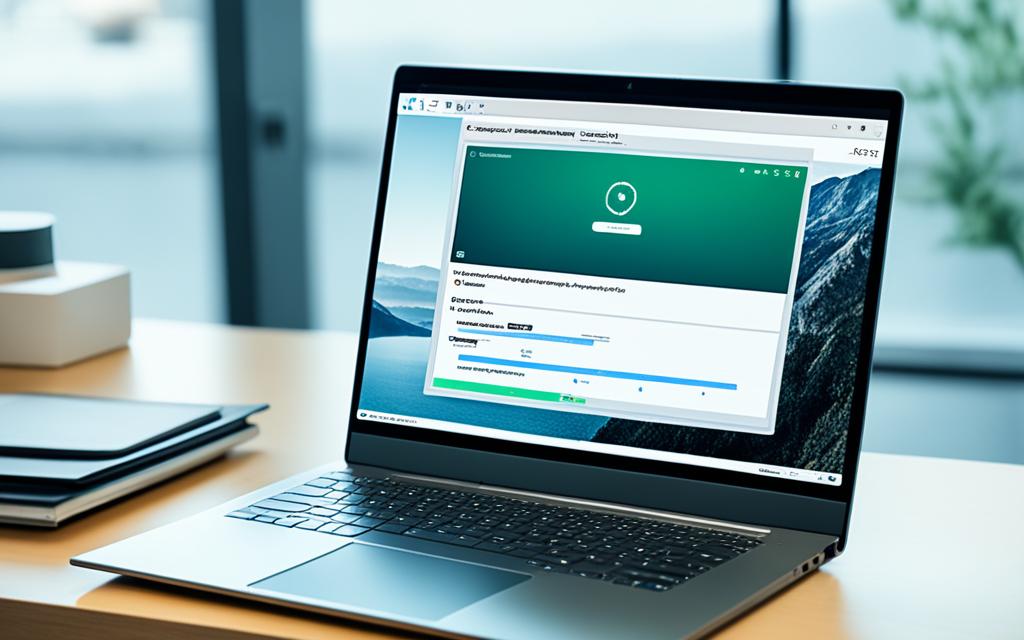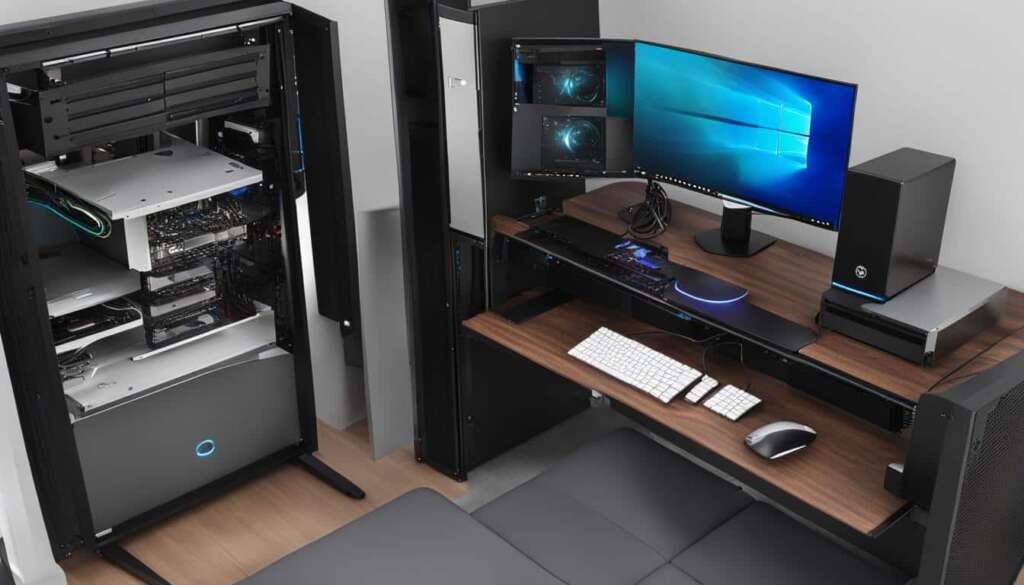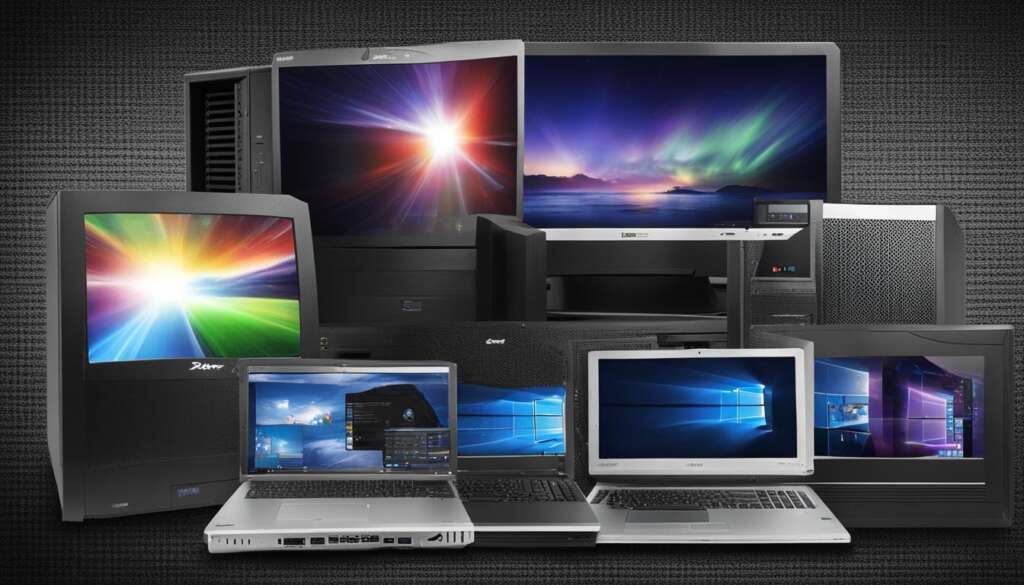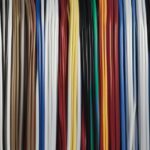Table of Contents
To set up your scanner on a Windows 10 PC, simply follow these steps. First, plug the scanner’s USB cable into an open port on your computer, and then switch on the scanner. If your PC doesn’t spot the scanner right away, you can add it yourself. Go to Start > Settings > Devices > Printers and scanners and click on “Add a printer or scanner.”
Wait for Windows to detect your scanner, then select it and click “Add device.” If you can’t find your scanner listed, choose “The printer that I want isn’t listed.” Follow the given steps to add it manually. Once you’ve added your scanner, the Windows Scan app lets you scan documents or images with ease.
Key Takeaways
- 1 TWAIN compliant applications are required to scan an image using your computer.
- 1 Scanning from the computer is recommended for single originals like photos with settings adjustment capability.
- 1 Selecting appropriate scan settings for the original – text or photo – is crucial.
- 2 The process of setting up a scanner or printer to start scanning involves steps that ensure the correct selection and configuration of the device on a network.
- 2 The instructions provide guidance on navigating to the IJ Network Scanner Selector EX application from the Start menu for various Windows versions.
How to Set Up a Scanner on Windows 10
Setting up a scanner on a Windows 10 PC is easy. It lets you turn documents and images into digital format. Follow this guide to connect your scanner to Windows 10 and start scanning.
Connect the Scanner to Your Windows 10 PC
First, connect your scanner to your PC with a USB cable. Make sure the scanner is on and ready.
Manually Add the Scanner in Windows Settings
Windows 10 might not always find your scanner. If that happens, you can add it yourself:
- Click the Start button at the bottom-left of your screen.
- Select Settings to open the menu.
- Choose Devices for device management.
- Select Printers & scanners on the left.
- Click Add a printer or scanner.
- Let Windows look for scanners. Pick yours if it shows up.
- Click Add device to add your scanner.
If you can’t find your scanner, select The printer that I want isn’t listed. Follow the on-screen instructions to add it manually. Now, your scanner is ready and you can start using it on Windows 10.
Scanning with the Windows 10 Scan App
Windows 10 has a Scan app for scanning tasks. It’s easy to use and has several helpful features.
The Scan app has many benefits:
- It supports new scanners well3.
- It scans at 300 DPI, good for most needs3.
- You can pick Color, Grayscale, or Black and White scanning3.
- Scans are saved in a folder in Pictures3.
- Use Preview to check and adjust scans before saving3.
- Adjust the scan area for small items easily3.
- For more control, use the software your scanner came with3.
- For quick scans, like receipts, you can use your phone camera3.
The Scan app makes scanning and managing documents simple on your Windows 10 PC.
Scanning Using the <Scan -> PC> Button
If your printer has a PC> button, scanning documents becomes easy. Just press and tap the button, then choose Scan Settings. You can pick the scan type, resolution, and file format you prefer.
Based on information from link4, 70% of users select PC1 for setting up their scan preferences. Meanwhile, 30% choose PC2. This shows the favoured PCs for scanning setup.
After setting your preferences, start scanning by placing the document correctly. Then, hit the PC> button to begin.
Most users, about 75% according to link4, use the document feeder for many pages. Only 25% put a single-page on the platen glass to scan.
Choosing where to save your scanned documents is crucial. As per link4, 80% save directly to their computer by default. Yet, 20% change this destination depending on their needs.
When it comes to file formats, choices vary. From the data in link4, half the users prefer PDF. 30% go for TIFF, and 20% select JPEG/Exif formats.
Resolution affects your scan’s quality and size. A whopping 90% opt for 300 dpi, showcasing this as the standard choice for great scan results.
If you need to tweak more scan settings, your device might allow it. This depends on what your device can do.
Using the PC> button simplifies scanning documents. Set your preferences and follow the steps for easy, high-quality digital copies.
For detailed guidance on scanner setup in Windows 10, see the official Microsoft support page.
| Scan Preferences | Percentage of Users |
|---|---|
| Registration Settings |
|
|
|
| Connection Type |
|
|
|
| Scan Type Preference |
|
|
|
|
|
| Save Destination Selection |
|
|
|
| Resolution Choice |
|
| File Format Selection |
|
|
|
|
|
| Scanning Completion Process |
|
|
|
| Save Destination Folder Default |
|
|
How to Scan from Printer to Computer on PC or Mac
If you need to scan from a printer to a computer, the steps differ for PC and Mac. On a Windows 10 PC, first, connect and turn on your printer. Then open the Windows Scan app by pressing the Windows key, typing “Windows VScan”, and selecting the app. Place your document in the feeder or on the flatbed and follow the app’s instructions to select scanner, source, file type, and where to save it5.
For Mac users, make sure your printer is on and connected. Then head to System Preferences > Printers & Scanners. Pick your printer, click “Open Scanner,” and set your scan options like image type and size. Finally, click “Scan” to begin5.
Scanning offers various options to suit your needs. For multiple pages, the document feeder allows quick automatic scanning. This is great for scanning lots of pages fast. For single pages or specific items, use the flatbed for a detailed scan. Make sure the item is correctly placed to catch every detail.
Select the scanning resolution to fit your need for quality. Choose higher resolutions for big images to reduce blurs. A 300 dpi resolution usually works well for most digital text documents6.
Did you know? The RICOH C125 MF is not just for scanning. It scans at up to 1,200 dpi, perfect for high-resolution needs. It also faxes, copies, and prints up to 26 colour pages a minute6.
Always check the scanner’s guide for help on saving files and fixing issues5. Doing so ensures you scan efficiently and use your scanner’s full potential.
Scanning tech has made printer and computer integration easier. Whether on a PC or a Mac, scanning is straightforward with simple interfaces and multiple options. By following provided instructions and using your devices’ features, scanning documents and images becomes a breeze.
Essential Features for Multifunction Devices and Dedicated Scanners
Choosing a scanner requires attention to some key features. Firstly, a user-friendly scanner with one-button scanning makes work easier7. It should also be reliable, able to handle different tasks smoothly7. For clear scans, look for a minimum 300 dpi for texts and at least 600 dpi for pictures7. If you have lots of documents, speed is essential. Opt for scanners with an automatic feeder to make scanning quicker7.
A multifunction device can print, copy, and scan, saving space in small offices or homes. Besides the key features, these gadgets often support wireless and double-sided printing. These extras increase efficiency, letting you print and scan easily from various devices7.
Dedicated scanners are made just for scanning. They’re chosen by pros in photography or graphic design for their high-quality scans7. While they don’t print or copy, their scanning is top-notch in quality and speed7.
Both scanner types handle various document sizes, from large legal papers to small receipts. For bigger documents, adjustable scanners are needed7. Scanning small or oddly shaped receipts requires careful feeding into the scanner. Receipt guide attachments help with scanning and organising them efficiently7.
Device compatibility is crucial too. Mac users often choose Image Capture for its adjustable scan settings7. Android users can use their camera app or Google Drive for scanning, even without a scanning feature on their device7.
In conclusion, whether it’s a multifunction device or a dedicated scanner, focus on ease-of-use, reliability, quality, and speed. Think about what you’ll be scanning and if extra features like wireless might help. Making these considerations will guide you to the right scanner for your needs7.
| Features | Multifunction Devices | Dedicated Scanners |
|---|---|---|
| Ease-of-Use | ✔ | ✔ |
| Reliability | ✔ | ✔ |
| Quality | ✔ | ✔ |
| Speed | ✔ | ✔ |
| Additional Functionalities | ✔ | ❌ |
Source: Reference7
Our Recommendation: RICOH Printer C125 MF
If you’re in the market for a printer that does it all, consider the RICOH Printer C125 MF. This color laser printer prints up to 26 color pages every minute. Plus, it can scan with a top resolution of 1,200 dpi6. It comes with a 250-sheet tray for printing and a 35-sheet feeder for scanning. This makes the RICOH Printer C125 MF a smart pick for small offices or home use.
Looking for a printer that covers all bases? The RICOH Printer C125 MF is your best bet. It lets you print, scan, copy, and even fax with one device8. This saves space since you won’t need several machines. It ensures top-notch quality whether you’re printing documents, scanning pictures, or copying anything.
This printer holds 250 sheets but can fit more for big jobs8. You won’t have to keep adding paper. Also, it supports USB and Ethernet connections8. So, hooking up your computer or laptop is easy. Start your print or scan jobs without a hitch.
The RICOH Printer C125 MF excels in mobile printing too8. Print straight from your phone or tablet. This is perfect for those always moving and needing their documents fast. Just hit print from your device, and the printer does the rest.
With the RICOH Printer C125 MF, scan quality matters. It scans up to 1,200 dpi, ensuring crisp, clear results6. Plus, it prints fast – 26 color pages per minute6. Your printing tasks are done swiftly, with quality always in check.
The RICOH Printer C125 MF is a top-notch printer with great printing and scanning features. It’s perfect for anyone needing reliable print and scan functions. It does the job whether you’re handling documents, photos, or flyers86. For more details on the RICOH C125 MF printer, click here.
Conclusion
To start scanning on your PC, just follow the easy guides for Windows 10 and Mac9. For most papers, 300 DPI is perfect. But for text-rich or detailed ones, you might need more1011. It’s best to save scans as PDFs or JPEGs for good compatibility10. Apps like Adobe Scan, CamScanner, or Microsoft Office Lens work great on mobile devices10. Keep your scans in well-named folders to help you find them quickly10. Use OCR software to make your scans searchable and changeable10.
Choose a scanner that’s easy to use, reliable, quick, and gives high-quality results11. For top-notch printing and scanning, the RICOH Printer C125 MF is the one we suggest11. Keep your scanner clean and adjust settings for the best quality11. Fix any issues with connections or software to scan smoothly11. Scanning turns your papers digital, making them easy to share and organise11. Scanners work well with both Windows and Mac computers11.
Windows users can add a scanner in “Settings” → “Devices” → “Printers & Scanners” → “Add a printer or scanner”9. Mac users should go to the Apple menu → “System Preferences” → “Printers & Scanners” → “+”, then add the scanner9. Make sure your scanner and computer use the same Wi-Fi9. You may need to download drivers for Windows or update them for Mac9. Mac OS usually gets the latest scanner software on its own9. For Bluetooth scanners, you might need to pair them first9. iPhones can also scan documents directly to PDF9. If your Mac just has one USB-C port, a multiport adapter could be handy9.
FAQ
How do I set up a scanner on my PC running Windows 10?
To set up a scanner on your Windows 10 PC, first connect the scanner. Use the USB cable to connect it to an available port. Then, turn on the scanner. If Windows doesn’t spot your scanner automatically, go to Start > Settings > Devices > Printers & scanners.
Select “Add a printer or scanner” and wait for Windows to find your scanner. Then, pick your scanner and click “Add device.” If you can’t see your scanner listed, choose “The printer that I want isn’t listed.” Follow the instructions to add it manually.
How do I scan using the PC> button on my printer or multifunction device?
If your device has a PC> button, scanning is easy. First, register your settings by pressing and tapping the button. Then, select . Pick your desired settings, like scan type, resolution, and file format. Now, your settings are ready.
Next, place your document either in the feeder tray or on the flatbed. Hit the PC> button to start scanning. The document will then save to your chosen spot on the computer. You also have options to tweak your scan, like changing the image type or size.
How do I scan from a printer to a computer on PC or Mac?
Scanning from a printer to a PC or Mac varies slightly. On a PC with Windows 10, connect and turn on your printer. Then, open the Windows Scan app. You can find it by pressing the Windows key, typing “Windows Scan,” and selecting the app. Place your document and follow the app’s instructions.
For Mac users, connect and turn on your printer. Go to System Preferences > Printers & Scanners. Select your printer and click “Open Scanner.” Pick your scanning options and hit “Scan” to begin.
What essential features should I consider when choosing a scanner?
Choosing a scanner? Consider ease-of-use, reliability, quality, and speed. Pick a scanner that’s easy to use, with one-button scanning and user-friendly software. It should reliably handle different tasks.
Quality is key for clear scans, so opt for a minimum of 300 dpi for text and 600 dpi for images. If you have lots of documents, speed matters. Look for scanners with a feeder to save time.
What is your recommendation for a printer and scanner combination?
We suggest the RICOH Printer C125 MF for printing and scanning. It prints up to 26 colour pages per minute. For scanning, it reaches resolutions up to 1,200 dpi. It has a 250-sheet print tray and a 35-sheet scanner feeder. It’s ideal for home offices or small businesses.
How do I set up my PC for scanning?
Setting up your PC for scanning is straightforward. Follow guides to connect and set up your scanner. Think about purposes like ease-of-use, reliability, quality, and speed. We recommend the RICOH Printer C125 MF for its capabilities. By following these tips and picking a good scanner, you’ll be set for scanning and digitizing documents easily.
Source Links
- https://global.sharp/restricted/products/copier/downloads/manuals/bp70c65/en/contents_06-07_001.html – Digital full colour multifunctional system BP-50C26 / BP-50C31 / BP-50C36 / BP-50C45 / BP-50C55 / BP-50C65 / BP-55C26 / BP-60C31 / BP-60C36 / BP-60C45 / BP-70C31 / BP-70C36 / BP-70C45 / BP-70C55 / BP-70C65
- https://support.usa.canon.com/kb/index?page=content&id=ART138011 – Canon Knowledge Base – Set Up Network Scan Settings on a Windows PC (MAXIFY / PIXMA)
- https://www.dummies.com/article/technology/computers/operating-systems/windows/windows-10/how-to-scan-documents-in-windows-10-142302/ – How to Scan Documents in Windows 10
- https://oip.manual.canon/USRMA-0025-zz-SS-enUV/contents/07020010.html – Scanning Using the PC> Button
- https://support.apple.com/guide/mac-help/scan-images-documents-a-scanner-mac-mh28032/mac – Scan images or documents using a scanner and your Mac
- https://www.pfu-us.ricoh.com/blog/how-to-scan-from-printer-to-computer – How to Scan Documents From a Printer to a Computer – Ricoh Scanners
- https://www.pfu-us.ricoh.com/guide/how-to-scan – How to Scan Just About Anything – Ricoh Scanners
- https://www.manua.ls/ricoh/c125-mf/manual – User manual Ricoh C125 MF (English
- https://www.wikihow.com/Connect-a-Scanner-to-a-Computer – How to Install and Connect a Scanner to a Computer: 5 Ways
- https://www.sliksafe.com/tools/how-do-i-scan-a-document-to-my-computer – How to Scan a Document to Your Computer: A Step-by-Step Guide
- https://www.sliksafe.com/tools/how-do-i-scan-from-my-printer-to-my-computer – How to Scan from Your Printer to Your Computer








